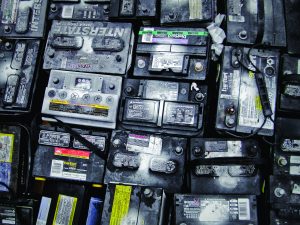
The components that made up your car battery probably lived a prior life, and most of it will probably live another life after you turn it in as part of the battery replacement process. It’s fair to ask how something so toxic can be so recyclable, because it doesn’t seem like it would be. But by recycling lead acid batteries, it’s possible to keep their toxic components out of waterways and landfills. Let’s break down what can be recycled and how these parts can have other lives in places you might not expect.
Your Old Lead Acid Battery Is Highly Recyclable

The different materials in a lead acid battery are highly recyclable. Each battery contains up to 20 pounds of lead, which is easily smelted and turned into lead ingots, which are then used to make new battery components, such as grids or terminals. Each battery can also contain up to a gallon of sulfuric acid, which can be used in future battery manufacturing or other products such as glass, textiles or detergents. Each battery can contain up to two pounds of plastic, which is typically processed to form new battery cases.
When old batteries arrive at a recycling facility, they’re taken apart and separated into their component parts. In fact, old, spent batteries are an important input in new battery manufacturing. All battery manufacturers depend on the flow of spent batteries back through the system in the production of new batteries. So much so that, in periods when the recycle flow slows, new battery prices increase because those new batteries are comprised of a greater percentage of virgin materials, which are more expensive than recycled content.
But How Can Highly Toxic Materials Like Battery Acid Be Recycled?

Despite the toxic components in lead acid batteries, they can be recycled because sophisticated systems have been put in place to reclaim their component parts. In fact, the battery (all types) recycling system in North America is one the most advanced and successful recycling systems in place today for any type of product. In this case, much of the recycling is done by the battery manufacturers themselves, resulting in a closed loop system where those same manufacturers derive a financial benefit from their recycling efforts. Because these recycling operations utilize advanced technologies to safely handle the dangerous materials contained in a lead acid battery, the batteries can be successfully recycled, without harm to people or the environment, despite the dangerous nature of the lead plate and acidic electrolyte.
Always Remember to Recycle Your Dead Lead Acid Battery

Luckily, it’s rather simple to recycle your old battery. In most cases, you can even get cash for your old battery or a credit toward the purchase of your new one. While they can’t go in a household recycling bin, batteries can be returned for recycling at almost any place that sells them. You will typically get more for your old battery if it is being used as trade-in (core) against the purchase of a replacement versus trying to just turn in your old battery. But, no matter what you get back for your spent battery, it still makes sense to turn it in for recycling, as most states and Canadian provinces prohibit the disposal of lead acid vehicle batteries. Do yourself, your neighbors and the environment a favor and recycle your battery. You’ll be glad you did.





